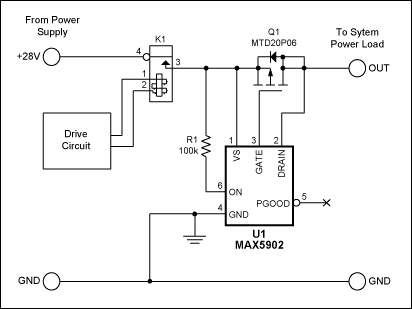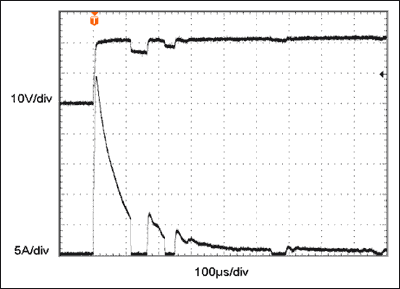Circuit Removes Relay-Contact Bounce
Abstract
Adding a p-channel MOSFET and a hot-swap controller IC to a mechanical relay removes relay-contact bounce and reduces inrush current.
A similar version of this article appeared as a design idea in the November 27, 2003 issue of EDN magazine.
Advances in semiconductor technology have allowed ICs to replace many mechanical relays, but relays still dominate in high-current circuits that must stand off high voltages of arbitrary polarity. Contact bounce in those relays, however, can prove troublesome to downstream circuitry.
One solution to contact bounce combines a relay with a hot-swap controller. Such controllers are increasingly popular as a means for switching system components without shutting down the system power. In Figure 1, a relay contact has replaced the pin of a mechanical connector.

Figure 1. A hot-swap controller IC and external MOSFET remove contact bounce from relay K1.
The system (drive circuit) drives the relay closed, and that relay closure connects the input of the hot-swap circuitry to the power supply (28V in this case). The hot-swap controller (U1) keeps the p-channel MOSFET (Q1) off for a minimum of 150ms after the input supply reaches a valid level. That delay allows ample time for contact bounce in the relay to subside. After the 150ms delay, U1 drives the MOSFET gate such that the output voltage slews at 9V/ms. This controlled ramp rate minimizes the inrush current, thereby reducing stress on the power supply, the relay, and capacitors downstream from the hot-swap controller.
An example of relay-contact bounce (Figure 2) shows three bounces with an inrush current peak of almost 30A. (The top trace is output voltage at 10V/div, the lower trace is input current at 5A/div, and the output load is 54Ω in parallel with 100µF.) Use of the Figure 1 circuit under these conditions gives a better picture (Figure 3). The delayed rise in output voltage is clearly visible, with no hiccups due to contact bounce. The input current shows much less variation, peaking under 1.5A before settling to a steady-state value of 500mA.

Figure 2. The mechanical relay K1 by itself exhibits contact bounce on closure.

Figure 3. The Figure 1 circuit removes relay-contact bounce and reduces inrush current."